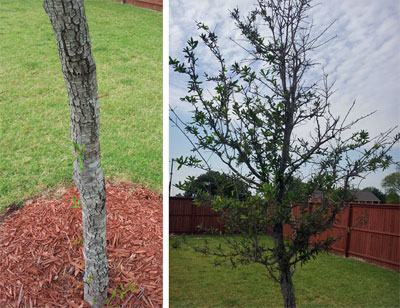Question and Answer – November 2012
If you’d like Neil’s help with your plant question, it’s as simple as taking a clear photo that illustrates it, then sending the question and photo to him here at e-gardens. In addition to requiring the photo, he also asks that you tell us the city where you garden. It’s a lot easier to give precise answers that way.
Question: What could be wrong with my St. Augustine? It’s looked this way for several months. I follow your guidelines, and I do water it regularly. One side of the walk recovered, but the other side did not. Its damage is spreading. When I pull on the blades, sometimes the runners come loose, but the longer this goes on, the more it’s just the blades that pull loose. I applied an insecticide, not only to stop any pest that might have been here, but also to keep bugs out of our house. What can I do? W.R.O., no city given.
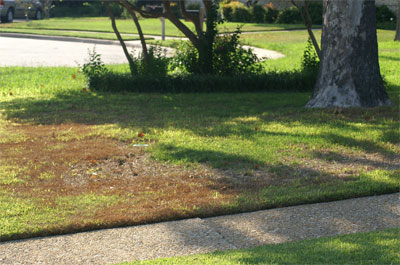
Answer: This looks like chinch bug damage, pure and simple. Note how the worst damage is in the sunniest, hottest parts of your lawn. The pests move in around mid-summer. They leave the turf looking dry, yet watering doesn’t correct the problem. If you get on your hands and knees and part the grass at the interface between dead and dying grass, you usually can see the b-b-sized black insects with irregular white diamonds on their wings. They’ll be most active in mid-afternoon, when it’s really hot. You will not see them now that the weather has cooled. Merit insecticide, applied at first signs of a problem, will be your best hope. You’ll probably have to resod much of this affected area next spring. This is severe damage. There was a great deal of it in Texas turf this year.
Question: I planted this crape myrtle earlier this year. It did well all season, but now it looks really stressed (yellowed edges to leaves, browned tips). Is this of any concern? A.B., Fort Worth.
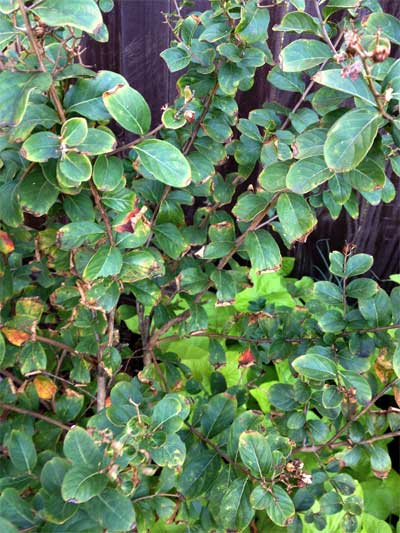
Answer: I don’t see any cause for concern here. My best guess would be that it got too dry at one short point sometime this summer (they often do). Anytime you see leaf margins and tips that are browning (the progression following yellowing), that’s usually moisture stress. Keep it watered properly over the winter. It should come out just fine next spring.
Question: I have this fungus in my soil every year. I know, from reading things you’ve written other times, that it is not a parasitic pest. But, it certainly does harm my flowers. Is there anything I can apply to it to kill it without hurting my desirable plants?
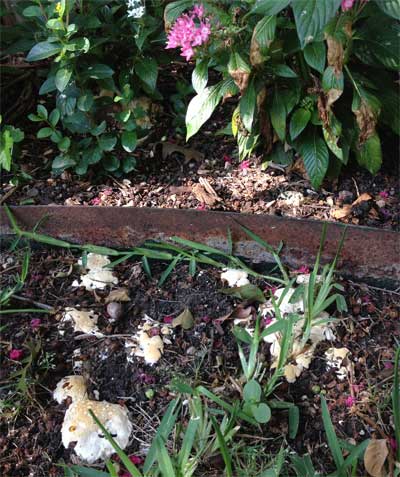
Answer: You’re correct. It’s a saprophytic fungus (lives off decaying organic matter, probably from the soil amendments you used). It will eventually run its course. Dusting sulfur applied to the top of the fungus will certainly help get rid of it. Keep the sulfur off the leaves of your pentas and other plants to prevent burning, and keep it out of your eyes. Another option might be to empty the bed after frost this fall and put down a layer of pine bark mulch, then grow flowers in large pots for a year or two. That would allow you to use a hoe to remove it physically, should it return.
Question: My St. Augustine lawn has been yellowed all summer. I spread peat moss in the spring for Take All Root Rot. I applied a quality fertilizer with slow-release nitrogen. It is not iron deficiency (yellow strips running the lengths of the blades along the veins). I haven’t seen the diamond-shaped spots you describe for gray leaf spot. My sprinklers run every day. Could the yellowing be from too much water? No name given. No city given.

Answer: That’s way too often for watering the lawn. You should recalibrate your sprinkler system to allow watering no more often than every third or fourth day. Better yet, have a smart controller installed. For a few hundred dollars, it will monitor all the conditions in each of your stations to determine when the system runs, and for how long. It will pay for itself within just a year or two in lowered water bills. I do not think this yellowing is due, however, to overwatering. This really does look like gray leaf spot. Look a little more closely, if the yellowing is still visible, for the gray/brown lesions along the midribs of the blades. Often, there won’t be many of them, but they’ll be evident. It’s late enough in the season that they may not be as apparent. For what it’s worth, I do not feed my St. Augustine between early June and early September. Gray leaf spot is most common during that time, so I add no additional nitrogen, slow-release or not. That’s really helped suppress the disease in my own lawn.
Question: My live oak tree has been in our yard for two years. It was part of a new landscape at that time. It’s not dead, but it is struggling. I see deep cracks in the trunk. Any advice? No name given. No city given.
Answer: My best guess is that this tree was balled-and-burlapped when it was moved and planted. There is a certain percentage of mortality when we do that, and it’s not uncommon to see live oaks look like this, especially in tract home developments, where builders buy large quantities and plant many at a time. Even container-grown trees (with all of their roots intact) can run into similar issues if they’re allowed to get too dry. The trunk splits may be due to sunscald. At this point, I might be tempted to give it one more spring. Trim it to remove dead twigs and branch ends, also to thin out some of the internal stubble. Apply a high-nitrogen fertilizer around it in late February or early March, and determine by this time next year if you want to save it. At that point, you could replace it, if needed, with a vigorous new tree. Fall is a superior time for planting.
Question: The leaves of my lacebark elm have turned yellow with green stripes down the middles. Does it need water, food, or is it Dutch yellow disease? Also, my Chinese pistachio tree is not nearly as full and lush as the other two in the neighborhood. Any suggestions would be helpful. M.P., Benbrook.
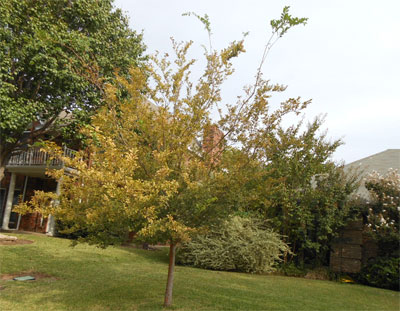
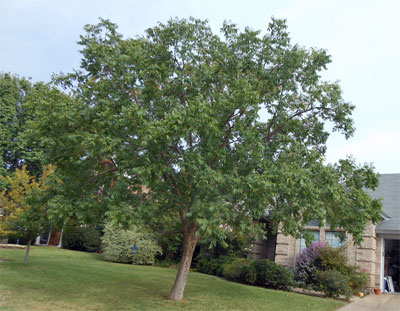
Answer: I don’t believe the lacebark elm needs any nutrients, but it would have benefited from more water at one or more times during the late summer and early fall. This looks like a young tree that might have gotten too dry. They’re fast-growing trees, and like other speedy trees, they run into drought problems. They’re also prone to lace bugs and cotton root rot, but those don’t appear to be involved with this tree. My guess is water. The pistachio looks good — nothing that a little more nitrogen and a little more water won’t help next year.
Question: When we moved into our house several years ago, we had a perfect carpet of grass. Now, it’s gradually receding and dying. It looks like it will be gone in a matter of time. The sprinklers are working fine, and we have no dogs or kids. What should I do at this point, sod or seed? L.D., Plano.
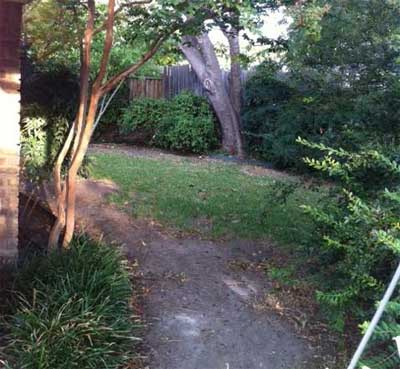
Answer: Neither. You already have St. Augustine. It’s our most shade-tolerant lawngrass. Adding more of it, when what you have is failing, would be folly. This is all due to a lack of sunlight, and it’s the most common question I get. In fact, I’ve lived the same story line beneath the many large native pecans on our property. If you’re on my Facebook page, or if you take our magazine, you’ll often see photos I’ve taken of our shady landscape. Here is the text of one of my Notes on my Facebook page.
Question: My wife and I have a bed of perennials on the northeast side of our house. This weedy vine keeps coming back year-after-year. We’re unable to do a lot of heavy physical work. Is there any way to eliminate this nasty vine without killing the perennials? B. and M.L.J., Fort Worth.
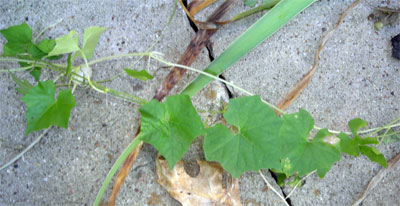
Answer: This is a weedy vine known by many as wild cucumber. It’s an aggressive grower that I have had to remove in my own gardens on many occasions. I’ve usually found it easiest to cut it off at the ground, either with loppers or with a sharpened hoe, then install a roll-type mulch between my perennials. Some of it will still try to come up in the open spaces where the perennials are, but at least this limits the number of total plants and much of the work of removing them physically. I conceal the unattractive roll mulch with an inch or two of pine bark or compost. After a year or two, the weed will be crowded out. There is no spray that will kill it without killing your desirable perennials.

